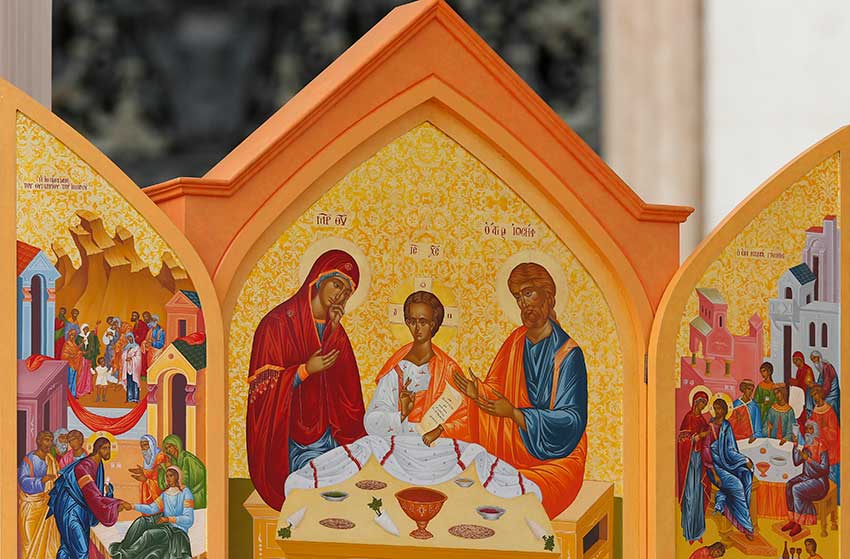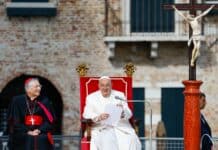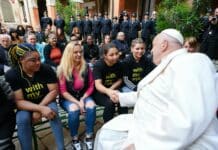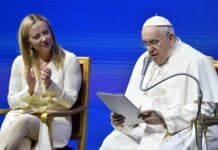Living the Season, with Kate Guilfoyle

Feast of the Holy Family – 13th January
The most efficacious method of embracing the depth of God’s love for us is by meditating upon the face of Jesus, or His Blessed Mother. Similarly, the most efficacious way to understand the potential of our particular family is by meditating on the Holy Family. We can take the opportunity on this feast day to reflect on the Holy Family as a model for our family lives.
The Holy Family was a family like no other. However, a meditation on the relationships that governed this family unit is not a dry and academic exercise: This was a family that operated in simple love and obedience to God’s will and to each other. It was a family that was not politically powerful or wealthy, but which, nevertheless, had an effect upon the world and humanity for the subsequent history of mankind. This was a family that changed the course of history and touched all of us.
In our times, it is especially important to understand and to teach the values of Christ within the Church at home. It can be beneficial to meditate upon those family values and to resolve to approach the tasks of the home and the relationships with family members with renewed generosity of spirit, humility and selflessness – to give love to each member of the family generously and to give without taking score.
Targeting the Family
However, there is another aspect to the family that has a potentially powerful political effect: The family is the nucleus of our society. It is for this reason that totalitarian regimes seek to target and destroy and to weaken the family bonds in order to indoctrinate the young. Herod tried to destroy the Holy Family. It is within the family unit that the young person learns to think as an individual, to develop a moral code by which the courage to resist populist doctrines can be imbued and where the values of a harmonious culture are instilled.
The Sexual Revolution’s fallout
The consequences of the sexual revolution demonstrate to us families that are split, sexuality that is confusing, and young people who are exposed to, and expected to participate in, behaviour for which they are not emotionally equipped. We are in a crisis in the Church where the sexual abuse scandals have resulted in a generation of priests and young people who have been scandalised and victimised by the actions of predatory individuals who have abused trust.
It would be naïve to think that the sexual exploitation within the community has ended with a Royal Commission or the metoo# movement. Respect for another comes from values instilled within the person, not from rules and sanctions applied in a moral and philosophical vacuum. Exploitation will continue regardless of media hype, because there is a fundamental hypocrisy within modern society, where sexual attraction and conquest is garnished to sell almost any imaginable product, fashion, career trajectory or ideology. The anxiety and emptiness of young people exposed to the exploitation and calculation of modern dating, demonstrates a complete lack of understanding in modern life of the concept of the sexual act as an act of giving of the self, rather than a taking of the other.
The battle is fought simply by living a life that reflects, as much as is possible, the values of the Holy Family and the teachings of Jesus Christ. In modern life, however, such determination itself is counter-cultural and requires thought, reflection and strength of will.
Finding freedom in Christ’s teaching
If embraced with a genuine and open attempt to truly understand them, the teachings of the Church provide a guide by which an individual is enabled to reach into his/her depths in order to become the best version of themselves. Collectively, the teachings of the Church, if applied to the family as a sacred creation, are capable of producing an entity in which the combination is stronger and more powerful than the individual members. To contemplate the Holy Family is to contemplate a family relationship that recognized the family as a loving unit, but the destiny of which was ultimately salvation through the Cross. The Catholic understanding of marriage is one in which God sanctifies through failures, trials and disappointments – through the Cross and not by any other means.
Many people, including practicing Catholics, do not understand the teachings of the Church on marriage and sexuality. It is a real challenge in the face of prevailing culture. We approach the timeless truths of the Church from a culture in which we have absorbed the values and perspectives of our times – we assume that the assertion of self is a virtue, an act of liberation. In a society in which it is seen as essential to have a high self–esteem, it is difficult to understand that humility is an act of freedom, not subservience, and that the assertion of self, (as opposed to faith and trust), is a prison that ultimately affects relationships. We do not understand the connections of community, connections that can only be forged by a focus on the other.
Become counter-cultural – take the first step
We can take the initiative ourselves, do some study and take the teachings of the Church to others, particularly the young who are most susceptible to the empty promises of our culture. In caring for our family and our teenage youth, it is important that they are educated and understand the teachings of the Church on sexuality and marriage so that they are aware of the beauty of her teachings, so that they are free to reject the demands of our culture because they know there is something better.
In conveying the Church’s teachings, however, we must be careful to make sure that our interpretation is an accurate representation of the position of the Church – we are not supermarket Catholics and we do not have the luxury of cherry-picking on doctrine. Useful texts include St John Paul II’s “Theology of the Body” and “Theology of the Body Explained” Christopher West, 2003, Gracewing; and generally, “The Catholic Church Saved my Marriage, Discovering Hidden Grace in the Sacrament of Matrimony”, Dr David Anders, 2018, EWTN.

Then… cook up the paella!
But the first step is to bring the family together, and celebrate and provide the opportunity to speak and support. I have set out a recipe for Paella here – as a wonderful, generous and joyous Spanish dish, it is perfect to share with members of the family. As you will recall, Our Lady, in her generosity of spirit, visited her cousin, Elizabeth, and spent three months with her when she needed help in her pregnancy. The feast of the Holy Family may be a good day to call up your cousins and other family members to break bread and share Paella!
Paella a La Maestre [Serves 4-6] [1], by Miguel Maestre
Ingredients
1 tablespoon olive oil
300g Calasparra rice
500g mussels
2 king prawns
1 blue swimmer crab, cleaned, quartered
4 baby calamari hoods, cleaned
4 yabbies
2 L fish or chicken stock
salt and pepper
200g fresh or frozen peas
2 lemons, halved
2 limes, halved
chopped parsley, to garnish
Sofrito
150ml olive oil
3 teaspoons sherry vinegar
3 large ripe oxheart tomatoes
½ chorizo sausage
3 eschallots, peeled
4 cloves garlic, peeled
4 piquillo peppers
½ bunch thyme, leaves only
½ bunch mint
½ bunch parsley
1 bunch chives
1 teaspoon saffron threads
1 teaspoon sweet paprika
1 teaspoon spicy paprika
1 teaspoon smoked paprika
1 To make Sofrito, process all ingredients in a food processor until smooth. Set aside.
2 Heat oil in large paella pan. Add rice. Cook, stirring occasionally, for about 5 minutes, or until it changes from white to transparent.
3 Stir in 12 large tablespoons of the Sofrito. Cook for 3 minutes. Add seafood and stock. Season. Cook, over medium heat for about 25 minutes or until stock has been absorbed and rice is almost tender. Reduce heat to low and cook for a further 3 minutes to form a nice “soccarada.” Move pan around to distribute the heat evenly. Add peas and remove from heat.
4 Stand, covered with a tea towel, for about 5 minutes. Squeeze over lemon juice and limes and season. Garnish with parsley. Serve paella warm, not steaming hot.
[1] Miguel Maestre Miguel’s Tapas, New Holland, at pp. 124-125.





